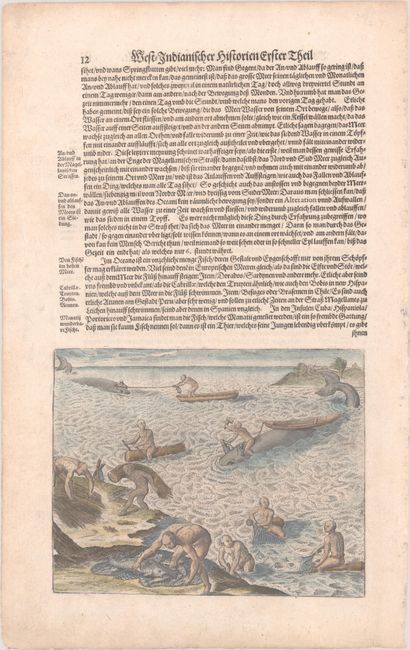Current Auction
"[Curious Method of Catching Whales]", Bry, Theodore de
Subject: West Indies & Peru, Natives
Period: 1631 (published)
Publication: Newe Welt und Americanische Historien...
Color: Hand Color
Size:
7.1 x 5.6 inches
18 x 14.2 cm
Download High Resolution Image
(or just click on image to launch the Zoom viewer)
(or just click on image to launch the Zoom viewer)
This copper engraving is from a remarkable series of publications, illustrating voyages of discovery and travels of exploration to various parts of the world. The project was begun by Theodore de Bry of Frankfurt, in 1590 and was to continue for another 54 years. They became known collectively as the Grands Voyages (to America and the West Indies) and the Petits Voyages (to the Orient and the East Indies). De Bry died after the first six parts of the Grands Voyages were completed. The project was completed initially by his widow and two sons, Johann Theodore de Bry and Johann Israel de Bry, then by his son-in-law, Matthaus Merian in 1644.
This unusual engraving first appeared in Part IX of de Bry's Grands Voyages in 1601, and was republished in Johann Ludwig Gottfried's Newe Welt und Americanische Historien, a collection of voyages. Also known as Historia Antipodum, Gottfried's work is an abridgement of de Bry's voyages to America that incorporates much new material. Matthaus Merian, de Bry's son-in-law and publisher for Historia Antipodum, was granted access to de Bry's copper-engraved plates. This engraving illustrates Indigenous fishing and whaling techniques. According to contemporary European accounts, the Indigneous whalers of the West Indies would paddle their canoes close to the whale, then jump on its back, and hammer wooden pegs into its nostrils to prevent it from breathing. Ropes would then be tied to the pegs so that once the whale was properly asphyxiated, it could be towed to shore. In the foreground, the native fishermen of Peru are shown sitting astride bundles of reeds to keep afloat while casting their nets. On a sheet of German text measuring 9.2 x 14.6".
References:
Condition: A
A nice impression with marginal soiling.
Estimate: $200 - $230
Current High Bid:
$0
Reserve: Reserve Not Met
Next Bid: $100
Bid Increments
$100 - $249$10
$250 - $499$25
$500 - $999$50
$1,000 - $2,499$100
Terms & Conditions



